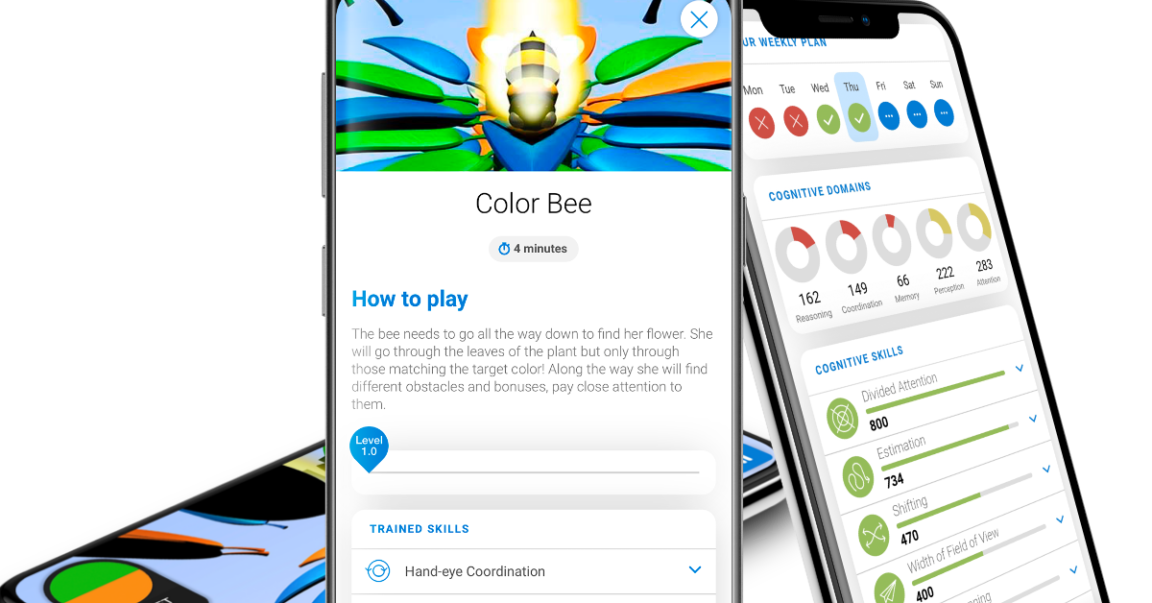
Color Bee – An Exciting Fast Paced Brain Game For Coordination
Experience our engaging cognitive stimulating brain games with the popular Color Bee!
Do you feel a bit like your coordination isn’t as strong as it once was? Maybe your mind used to be quick as a whip but is now taking a little longer to respond? How about your agility? Meaning, do you need to keep an eye out for pesky doors and table corners to avoid bumping into them?
If so, then Color Bee might just be the perfect brain game for you.
WHAT IS COLOR BEE?
It’s quite simple. Color Bee is an exciting, challenging 3D puzzle game that tests your Spacial Perception, Hand-eye Coordination, and Response Time as you help the fast-paced bee avoid obstacles and clear the leaves away. However, don’t let this first-level easiness fool you. As the levels progress, so will the difficulty!
Spin the bee around the plant to find the right leaves. Just use the Left/Right Arrow keys and then tell it when to dive down using the Down arrow key.
THE SCIENCE BEHIND COLOR BEE
This deceptively simple, exciting game is more than just a fun way to pass the time. It has been designed purposefully to train specific cognitive abilities in a simple and exciting way. Users need to quickly navigate a complex visual scene while staying alert to dangers, obstacles, and changing goals. These simple actions are a fantastic way to put your critical cognitive skills to the test.
Let’s take a look at these core abilities, how they help us with tasks, both simple and complex, and what makes them so important to everything we do.
Spatial Perception

Spatial perception is the ability to be aware of our relationship to both the environment around us and with our own physical self. While this may all sound quite complex, it really comes down to this: Spatial Perception is what allows us to understand our environment and where we are within it.
Spatial awareness is made up of two processes. First is the exteroceptive process. This creates representations about our space through feelings. The second is the interoceptive process. This creates a representation of our body, such as its position or orientation.
- If you have ever tried parking a car, you were using the exteroceptive process to understand and evaluate your environment. This lets you know if your car will fit in the space.
- How about walking down the hallway and effortlessly hopped up a few stairs without really thinking about it? You were using the interoceptive process. This allowed you to understand the position of your feet and raise them at the correct moment.
- And, we’ve all smashed our little toe on something. In that case, our exteroceptive and interoceptive processes weren’t working as well as they should.
Spatial Perception is what allows us to complete complex tasks such as drawing, driving, or playing sports without going outside of the lines.
Hand-Eye Coordination

Activities that require us to use the information our eyes perceive (visual-spatial perception) to guide our hands to carry out a movement rely on Hand-Eye Coordination.
It can be something as simple as reaching to grab an object. We use the information gathered through our eyes regarding the shape, size, distance, and even speed of the object. This allows our brains to inform our hands how to manipulate the object.
We use Hand-Eye coordination for an almost limitless amount of activities we perform every day. Think about it – from driving to drinking a glass of water or typing on your keyboard. Even activities as seemingly simple as walking or waving our hand require the use of Hand-Eye Coordination.
Response Time

Response Time is sometimes called reaction time. It refers to the time that takes place between when we perceive something to when we respond to it. It is the ability to detect, process, and respond to a stimulus. It’s one of the most important cognitive skills because nearly everything we do relies on our ability to process information and develop an appropriate response.
For example, when you are wide awake and full of energy, you are able to quickly reply to questions. This includes changes in your environment or responses to perceived rustburgpharmacy dangers. You can do this more quickly than when you are completely exhausted. Granted, these are obvious situations. However, there are more gradual, less noticeable, changes that happen over time due to the effects of age, poor diet and exercise, or physical and mental illnesses.
Maintaining an active and stimulated mind is one of the keys to promoting healthy Response Time so we can continue to safely enjoy the many activities that rely on this cognitive ability.
RECAP OF COLOR BEE
Whether you are looking for a way to specifically train Spatial Perception, Hand-eye Coordination, or Response Time, or you simply want a fun game with some great cognitive benefits, Color Bee is a fantastic choice for you and your loved ones! We hope you enjoy Color Bee as much as we do
Also, we would love to hear your stories about cognitive improvement using this or any of CogniFit’s games and tools. Just give a shout-out on any of our social media channels!
BONUS – MANY NEW GAMES … AND OFTEN!
We want to continue growing and building the best possible CogniFit, as well as continue to provide the highest quality services to those who have placed their trust in our platform to strengthen their cognitive abilities through our scientific cognitive evaluation and brain training tools. This is why we aim to create new games on a regular basis. So, keep an eye out!
And, with all CogniFit games, you will find unique, engaging experiences designed to stimulate the vital cognitive abilities we use each and every day. Also, they are all created by experts in neuroscience, and designed with a scientific and academic focus.
As we always say: At CogniFit, we don’t make games, we make unique experiences!
Carlos Rodrigues – CEO CogniFit














